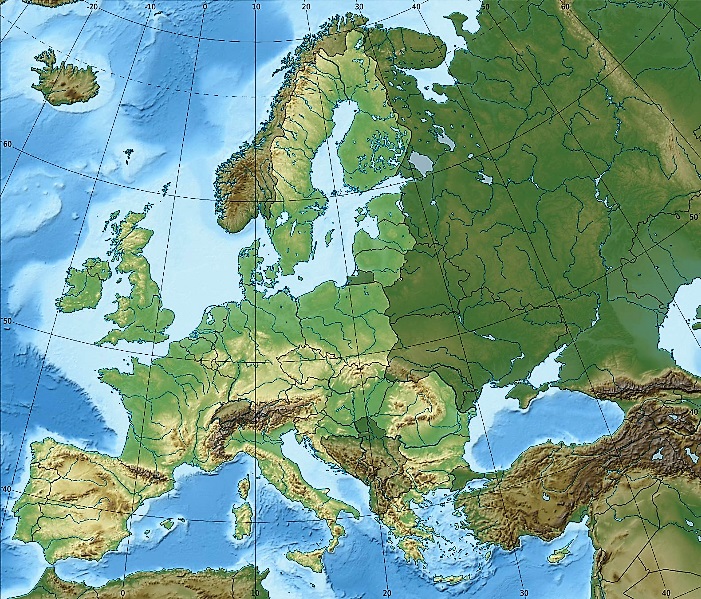Welcome at this page about
~ "Norteurom" ~
(The "Northern-Europide Movement")
Satellite photo of Europe above the 50th degree of latitude
("Northern-" or "Temperate Europe")
---------
The
"Northern-Europide Movement"
is an appeal to all (full as well as predominantly) members
of the Northern-Europide (blond and blue-eyed) human race, to legally
do and leave behind as much as possible of what has to be done respectively
left behind, to stop and reduce more and more the now growing threat
of their race becoming eliminated by other races
genetically as well as in other ways.
----------
INTRO
"Blonds are becoming extinct"
This was the title of a report in a Dutch magazine in 1998. ---
It reported about a paragraph in weekly magazine Vogue, of which a correspondent contacted Prof. S. Jones of London University, with a question about blond hair.
The Professor replied that "blond" is becoming extinct; due to this mainly is the fact that the gen, that causes black hair, generally dominates the blond-gen in case of mixed procreation.
Now that people on Earth have more and more contacts with persons of other races, this leads to a growing percentage of births of blackhaired children, and as a result a continuously decreasing occurence of blondhaired persons.
The content of that article was felt as very alarming on Northern-Europide side and was one of the main causes of Norteurom coming to existance.
----------
About "Blond"
Naturally people in tropical and subtropical area's (so from equator, up to both 50th degrees of latitude) are blackhaired.
In the Northern Hemisphere there is also normally habitable land between the 50th and the 75th degree of latitude. (Canada, Northern-Europe and Siberia). This not so sunny zone is called the "temperate zone".
The temperate zone in its turn, can be divided in three sub-zones of which the distance to the sun (and the equator) is essentially different: the upper (above the 60th degree), the middle (between the 55th and the 60th) and the lower one (from the 50th up to the 55th). Generally spoken the more southern the subzone is situated, the more intens the sun's rays are .
Corresponding with the differences in distance to the sun and as a result intensity of the sun's rays is the people's need of pigment for protection against dangerous ultraviolet-radiation that is part of the sun's rays. The closer the zone or sub-zone is located to the equator, the bigger the need of pigment is. As this pigment is brown and finds itself in skin, hair and eyes, people's skin, hair and eyes are the darker, the closer the zone or sub-zone in which they naturally belong finds itself to the equator. As a result people who naturally belong quite near to the equator are more or less darkbrown skinned and -eyed and deep black-haired, whereas on the other people who naturally belong the furthest from the equator (like in Northern-Skandinavia) are as good as pigmentless and so as good as white skinned, white-haired (very light blond) and light-blue-eyed. In between pigmentation increases as the distance to the equator becomes smaller.
(For that matter not only people's appearance differs according to the distance of their natural habitat to the equator, but also their temperament and other internal settings).
As a result, not all people in the temperate climate zone are very light-blond (sometimes called white-) haired. In principle (naturally) this only is the case above the sixtieth degree of latitude (so about off Finland and Iceland). Skin is also very low pigmented and so very light. Eyes are very light-bleu.

(Light blond hair)
In the middle sub-zone (between te 55th and the 60th degree of latitude; so about off Denmark and southern Sweden)) in principle hair color is medium blond (lighter to darker variants of beige). Skin is proportionally less light and eyes less light bleu.
.jpg?timestamp=1499805877928)
(Medium-blond hair)
In the lower one (between te 50th and the 55th degree of latitude; so about off Belgium and Netherlands) , hair in principle is darkblond or goldblond, whereas skin is that pigmented that in summer it can be light brown and eyes are proportionally less light bleu.

(Dark blond hair)
So notwithstanding the differences in variaties, throughout the temperate main zone autochtone people naturally are blond (= otherwise than black or brown) haired, blue-eyed and more or less light skinned.
Besides the degree in which pigment is present in the skin is not only decisive for the degree in which one is protected against uv-radiation, but also for the degree in which the sun's rays are able to 'get through' the upper skin in order to do their laudable work inside, like for instance generating D-vitamins.

(Gold-blond hair)
As for the variant of "goldblond" by the way some further explanation may (still) be appropriate here. In principle (= naturally) this variant of blond (often still uncorrectly called "red") genetically is resulting from mixed procreation of sub-tropical black and temperate blond, which naturally particularily occurs in transitional area's between both mentioned main zones. If in case of this 'mixed' procreation the blond gen has to dominate strongly (in order to maintain or restore natural proportions), this variant of blond is the result, whereas in case the black gen dominates, this mostly results in black hair combined with bleu eyes or in brown hair mostly combined with subtropical brown eyes; (both naturally most 'at home' between the 45th and the 50th degree of latitude; so about off France and southern-Germany).
----------
About the threat of blond becoming extinct
Naturally there is no threat that blond will become eliminated by black.
For if mankind lives in just its naturally own region, there is only 'mixed' procreation in transitional zones.
Now that however by use of especcially motorised means of transportation humanity is swarming around all over the planet, the danger of blond genetically and in other ways becoming eliminated by (sub-)tropical black and brown is very realistic.
For not only the fact that there is about five times as much land in the joint sub-tropical and tropical zones than there is in the temperate ones naturally causes that there are at least five times as many blackhaired than blondes, but moreover, due to certain unnatural causes, population numbers in those 'black-haired' African and Asian countries where hardly any or no preservatives are used, have increased a lot stronger than naturally, as a result of which meanwhile there are more than fifty times as many (predominantly) (sub-)tropical persons than blondes.
Indeed, the last mentioned by now form not any more the natural 20% of mankind's total, but only less than 2% any more.
If this developement would continue unchanged, in about 20 years there would be more than hundred blackhaired on one blond, as nowadays total Earth's population of more than 7 miljard then would have raised up to 10 miljard, whereas both the number and the percentage of blondes (also due to the cause as mentioned up above) would be reduced to as good as zero .
But according to other scientists it will not get that far, because by that time allready overpopulation of the planet (with mainly blackhairds) will have caused a total exhaustion of natural resources, essential for it's liveability .
Therefore it must be said that it's also very much in the interest of blackhaired Earth inhabitants that growth of their number is stopped as soon as possible. Otherwise ironically enough they will become extinct as a result of Earth's unliveability, at about the same time as blonds will genetically.
-----------

Above the 50th degree of latitude (the Northern Temperate climate zone), natural territory of blondes in the Northern hemisphere.
.jpg?timestamp=1499797003359)
The Sub-Tropical and Tropical zones(in between the Northern and the Southern 50th degrees of latitude); (natural territory of the non-blondes).
.jpg?timestamp=1499797101275)
The Southern Temperate (and Polar) Climate zone (beneath the 50th degree of latitude); (natural territory of blondes in the Southern hemisphere with only very little land).
-------

Map showing where exactly in Europe the 50th degree of latitude in the Northern hemisphere finds itself; (viewed from below it's the second line running from the left to the right (passing just below England))
----------